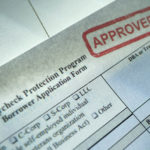By Adam Cmejla, CFP®

Nov. 18, 2020
The only trait about the Paycheck Protection Program that has remained constant throughout 2020 has been that it keeps changing.
On the evening of November 18, the IRS released additional guidance in the form of Rev Ruling 2020-27 on the tax deductibility of expenses paid using PPP loan proceeds. The guidance from the IRS confirms the IRS’s earlier position outline in Notice 2020-32 that expenses paid with PPP funds are not deductible to the business.
Equally important was the clarity that expenses paid in 2020 are not deductible even if forgiveness is not applied for until 2021, assuming that the borrower “reasonably expects” to have its PPP loan forgiven. If the PPP loan is not forgiven as expected, the Service also issued Revenue Procedure 2020-51 providing safe harbor on the deductibility of expenses paid with PPP funds that were not forgiven, assuming (3) criteria are met. The rationalization behind this move is seemingly to encourage borrowers to apply for forgiveness ASAP. While “reasonably expects” can be open for interpretation, I encourage all practice owners to communicate their actions with their professional team.
Here are the remaining points of uncertainty, including what you should do in light of that uncertainty.
Taxability of Funds
It’s important to understand how these funds are classified from an accounting perspective and, consequently, the potential tax ramifications of these funds to the practice owner. Equally important is understanding the timing repercussions of the following decisions.
First, to make the math easy, let’s assume that the practice in this hypothetical example received a $100,000 PPP loan and that 100 percent of the PPP funds received were used for qualified expenses, thus allowing the entire loan to be forgiven. This includes payroll, rent, utilities, etc.
The $100,000 that you received in PPP funds is both an asset (cash) and a long-term liability on your balance sheet and should not be reflected on your income statement…yet.
The CARES Act stipulates that PPP funds are non-taxable to the business—which is great.
If you go through the process of applying for loan forgiveness and you receive notice that the bank has forgiven 100 percent of your PPP loan, you must understand the implications of that decision and what it means to your financial statements and eventually your tax return.
Put simply: the amount of your PPP is now going to shift FROM your balance sheet as a liability TO your income statement, but not as you might think.
To continue our example, let’s say that your practice is set up as an S-corporation. If you’re like a lot of practices we work with, the remainder of 2020 has been one of your better years in business. This is translating to close-to-normal looking financial statements for the back half of the year.
Other Articles to Explore
What this means to you as the practice owner is that the $100,000, by virtue of the loan being viewed by Treasury as debt extinguishment, will be reported on your 1120-S (S-corporation tax return) as tax-exempt income to the business and this income will also be added to the rest of your “normal” taxable income that is generated by the practice through normal practice operations.
We must understand that there’s a ripple effect that was published in IRS Notice 2020-32, which states that any expenses that were paid with (essentially) tax-free PPP funds are no longer a deductible expense to the business as this treatment prevents a double tax benefit (tax-exempt income AND the ability to deduct the associated expenses paid with those funds). This will be reflected on your P/L not as additional income, but rather, as a credit to your expenses.
As a practice owner, this affects you directly because the non-deductibility of an expense to the business has a “flow through” effect of being taxable to you at the personal level!
Instead of getting a $100,000 deduction for the expenses that were paid with PPP funds, you’ll potentially owe taxes at your personal ordinary income rate. For an OD in the 24 percent tax bracket, this could potentially translate into a possible $24,000 tax liability, so the net effect of the PPP program to you as a business owner is $76,000.
While the PPP did provide you with an additional $100,000 of resources to use in your practice, you’re losing $24,000 in tax deductions that you’d normally be taking as an expense in your business.
Remember, expenses that are paid with taxable income to the business (i.e. revenue generated by the practice) are a deductible expense. Because an S-corporation doesn’t pay taxes directly but rather “flows through” to the owner’s tax rate, the value of the deductible expense is essentially the owner’s personal income tax rate.
Timing Matters
If you file for forgiveness in 2020, and therefore, have addition income that is going to flow through to your personal return, how are your quarterly tax estimates being impacted? Are you going to have an underpayment penalty because of the significant delta between your estimated income and the reality of your return?
Clearly, we don’t have clarity on the full implications of the PPP forgiveness process. There may be additional benefits by waiting until you’ve had proactive conversations with your CFP®, your CPA, and your financial institution to understand the implications of forgiveness on your personal tax situation.
I’m usually one that advocates for ODs taking action. This is one situation where I’m recommending that the action to take right now is one that is coordinated with your professional team. Acting solo without guidance could lead to additional time having to be spent next tax season and a surprisingly higher tax bill than you anticipated.
 Adam Cmejla, CFP® is a CERTIFIED FINANCIAL PLANNERTM Practitioner and Founder of Integrated Planning & Wealth Management, LLC, an independent financial planning & investment management firm focused on working with optometrists to help them reach their full potential and achieve clarity and confidence in all aspects of life. For a number of free resources, visit https://integratedpwm.com/ebooks/ and check out the “20/20 Money Podcast” to get more tips on making educated and informed financial and business decisions
Adam Cmejla, CFP® is a CERTIFIED FINANCIAL PLANNERTM Practitioner and Founder of Integrated Planning & Wealth Management, LLC, an independent financial planning & investment management firm focused on working with optometrists to help them reach their full potential and achieve clarity and confidence in all aspects of life. For a number of free resources, visit https://integratedpwm.com/ebooks/ and check out the “20/20 Money Podcast” to get more tips on making educated and informed financial and business decisions



























